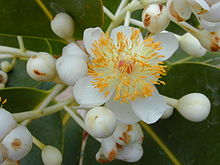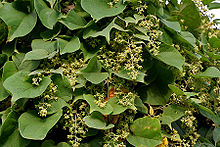- Malpighiales
-
Malpighiales 
Flower of Calophyllum inophyllum Scientific classification Kingdom: Plantae (unranked): Angiosperms (unranked): Eudicots (unranked): Rosids Order: Malpighiales
MartiusFamilies See text.
Malpighiales is one of the largest orders of flowering plants, containing about 16000 species, approximately 7.8% of the eudicots.[1] The order is very diverse and hard to recognize except with molecular phylogenetic evidence. It is not part of any of the classification systems that are based only on plant morphology. Molecular clock calculations estimate the origin of stem group Malpighiales at around 100 Mya (million years ago) and the origin of crown group Malpighiales at about 90 Mya.[2]
Malpighiales is divided into 32 to 42 families, depending upon which clades in the order are given the taxonomic rank of family.[3] In the APG III system, 35 families are recognized.[4] Medusagynaceae, Quiinaceae, Peraceae, Malesherbiaceae, Turneraceae, Samydaceae, and Scyphostegiaceae are consolidated into other families. The largest family, by far, is Euphorbiaceae, with about 6300 species in about 245 genera.[5]
In a 2009 study of DNA sequences of 13 genes, 42 families were placed into 16 groups, ranging in size from one to ten families. Almost nothing is known about the relationships among these 16 groups.[3] Malpighiales and Lamiales are the two large orders whose phylogeny remains mostly unresolved.[6]
Contents
Affinities
Malpighiales is a member of a supraordinal group called the COM clade, which consists of the orders Celastrales, Oxalidales, and Malpighiales.[7] Some describe it as containing a fourth order, Huales, separating the family Huaceae into its own order, separate from Oxalidales.[8]
Some recent studies have placed Malpighiales as sister to Oxalidales sensu lato (including Huaceae),[3][9] while others have found a different topology for the COM clade.[2][7][10]
The COM clade is part of an unranked group known as Fabidae or eurosids I.[11] The fabids, in turn, are part of a group that has long been recognized, namely, the rosids.[12]
History
The great Swedish botanist Linnaeus named the genus Malpighia in honor of Marcello Malpighi's work on plants; Malpighia is the type genus for the Malpighiaceae, a family of tropical and subtropical flowering plants.
The family Malpighiaceae was the type family for one of the orders created by Jussieu in his 1789 work Genera Plantarum.[13] Friedrich von Berchtold and Jan Presl described such an order in 1820.[14] Unlike modern taxonomists, these authors did not use the suffix "ales" in naming their orders. The name "Malpighiales" is attributed by some to Carl von Martius.[12] In the twentieth century, it was usually associated with John Hutchinson, who used it in all three editions of his book, The Families of Flowering Plants.[15] The name was not used by those who wrote later, in the nineteen seventies, eighties, and nineties.
The first semblance of Malpighiales as we now know it came from a phylogeny of seed plants published in 1993 and based upon DNA sequences of the gene rbcL.[16] This study recovered a group of rosids unlike any group found in any previous system of plant classification. In order to make a clear break with classification systems being used at that time, the Angiosperm Phylogeny Group resurrected Hutchinson's name, even though his concept of Malpighiales included much of what is now in Celastrales and Oxalidales.[17]
Circumscription
Malpighiales is monophyletic and in molecular phylogenetic studies, it receives strong statistical support.[1] Since the APG II system was published in 2003, minor changes to the circumscription of the order have been made. The family Peridiscaceae has been expanded from two genera, to three, and then to four, and transferred to Saxifragales.[3][18]
The genera Cyrillopsis (Ixonanthaceae), Centroplacus (Centroplacaceae), Bhesa (Centroplacaceae), Aneulophus (Erythroxylaceae), Ploiarium (Bonnetiaceae), Trichostephanus (Samydaceae), Sapria (Rafflesiaceae), Rhizanthes (Rafflesiaceae), and Rafflesia (Rafflesiaceae) had been either added or confirmed as members of Malpighiales by the end of 2009.[3]
Some family delimitations have changed as well, most notably, the segregation of Calophyllaceae from Clusiaceae sensu lato when it was shown that the latter is paraphyletic.[3] Some differences of opinion on family delimitation exist as well. For example, Samydaceae and Scyphostegiaceae may be recognized as families or included in a large version of Salicaceae.[19]
Phylogeny
As we know it in 2009, the phylogeny of Malpighiales is, at its deepest level, an unresolved polytomy of 16 clades. It has been estimated that complete resolution of the phylogeny will require at least 25000 base pairs of DNA sequence data per taxon.[20] A similar situation exists with Lamiales and it has been analyzed in some detail.[21] The phylogenetic tree shown below is from Wurdack and Davis (2009). The statistical support for each branch is 100% bootstrap percentage and 100% posterior probability, except where labeled, with bootstrap percentage followed by posterior probability.
Malpighiales 98/100 Lophopyxidaceae
84/100 84/100 Ctenolophonaceae
Rhizophoraceae s.l. 99/100 Balanopaceae
Chrysobalanaceae s.l. Euphroniaceae
Ochnaceae s.l. Medusagynaceae
clusioids 92/98 Calophyllaceae
Hypericaceae
phyllanthoids Peraceae
90/90 85/100 parietal clade 76/98 Goupiaceae
82/100 Passifloraceae s.l. Malesherbiaceae
Salicaceae s.l. Scyphostegiaceae
References
- ^ a b Peter F. Stevens (2001 onwards). Malpighiales At: Angiosperm Phylogeny Website At: Missouri Botanical Garden Website
- ^ a b Susana Magallón and Amanda Castillo (2009), "Angiosperm diversification through time", American Journal of Botany 96 (1): 349–365, doi:10.3732/ajb.0800060, PMID 21628193
- ^ a b c d e f Kenneth J. Wurdack and Charles C. Davis (2009), "Malpighiales phylogenetics: Gaining ground on one of the most recalcitrant clades in the angiosperm tree of life", American Journal of Botany 96 (8): 1551–1570, doi:10.3732/ajb.0800207, PMID 21628300
- ^ Angiosperm Phylogeny Group. 2009. "An update of the Angiosperm Phylogeny Group classification for the orders and families of flowering plants: APG III". Botanical Journal of the Linnean Society 161(2):105-121. doi: 10.1111/j.1095-8339.2009.00996.x
- ^ Alan Radcliffe-Smith. 2001. Genera Euphorbiacearum. Royal Botanic Gardens, Kew: Richmond, England.
- ^ Douglas E. Soltis, Pamela S. Soltis, Peter K. Endress, and Mark W. Chase (2005), Phylogeny and Evolution of the Angiosperms, Sunderland, MA, USA: Sinauer, ISBN 978-0878938179
- ^ a b Hengchang Wang, Michael J. Moore, Pamela S. Soltis, Charles D. Bell, Samuel F. Brockington, Roolse Alexandre, Charles C. Davis, Maribeth Latvis, Steven R. Manchester, and Douglas E. Soltis (10Mar2009), "Rosid radiation and the rapid rise of angiosperm-dominated forests", Proceedings of the National Academy of Sciences 106 (10): 3853–3858, doi:10.1073/pnas.0813376106, PMC 2644257, PMID 19223592, http://www.pnas.org/content/106/10/3853.abstract?etoc
- ^ Alexander B. Doweld. 2001. Prosyllabus Tracheophytorum. Tentamen systematis plantarum vascularium (Tracheophyta). Geos: Moscow, Russia.
- ^ Li-Bing Zhang and Mark P. Simmons (2006), "Phylogeny and delimitation of the Celastrales inferred from nuclear and plastid genes", Systematic Botany 31 (1): 122–137, doi:10.1600/036364406775971778
- ^ J. Gordon Burleigh, Khidir W. Hilu, and Douglas E. Soltis (2009), File 7, "Inferring phylogenies with incomplete data sets: a 5-gene, 567-taxon analysis of angiosperms", BMC Evolutionary Biology 9: 61, doi:10.1186/1471-2148-9-61, PMC 2674047, PMID 19292928, http://www.biomedcentral.com/content/supplementary/1471-2148-9-61-S7.pdf
- ^ Philip D. Cantino, James A. Doyle, Sean W. Graham, Walter S. Judd, Richard G. Olmstead, Douglas E. Soltis, Pamela S. Soltis, and Michael J. Donoghue (2007), "Towards a phylogenetic nomenclature of Tracheophyta", Taxon 56 (3): 822–846., doi:10.2307/25065865, http://www.phylodiversity.net/donoghue/publications/MJD_papers/2007/164_Cantino_Taxon07.pdf
- ^ a b Peter F. Stevens (2001 onwards), Angiosperm Phylogeny Website, http://www.mobot.org/MOBOT/Research/APweb/welcome.html
- ^ Antoine Laurent de Jussieu (1789), Genera Plantarum, Paris: Herrisant and Barrois, p. 252, http://books.google.com/?id=qjUhAAAAYAAJ&dq=antonii+laurentii+genera+plantarum&printsec=frontcover&q=
- ^ James L. Reveal (2008 onward), "A Checklist of Family and Suprafamilial Names for Extant Vascular Plants", Home page of James L Reveal and C. Rose Broome, http://www.plantsystematics.org/reveal/pbio/fam/supgennames.html
- ^ John Hutchinson The Families of Flowering Plants 3rd edition. 1973. Oxford University Press.
- ^ Mark W. Chase et alii (42 authors). 1993. "Phylogenetics of seed plants: An analysis of nucleotide sequences from the plastid gene rbcL". Annals of the Missouri Botanical Garden 80(3):528-580.
- ^ The Angiosperm Phylogeny Group (2003), "An update of the Angiosperm Phylogeny Group classification for the orders and families of flowering plants: APG II", Botanical Journal of the Linnean Society 141 (4): 399–436, doi:10.1046/j.1095-8339.2003.t01-1-00158.x, http://www3.interscience.wiley.com/cgi-bin/fulltext/118872219/PDFSTART
- ^ Douglas E. Soltis, Joshua W. Clayton, Charles C. Davis, Matthew A. Gitzendanner, Martin Cheek, Vincent Savolainen, André M. Amorim, and Pamela S. Soltis. 2007. "Monophyly and relationships of the enigmatic family Peridiscaceae". Taxon 56(1):65–73.
- ^ Mac H. Alford. 2007. "Samydaceae". Version 06 February 2007". In: The Tree of Life Web Project.
- ^ Shuguang Jian, Pamela S. Soltis, Matthew A. Gitzendanner, Michael J. Moore, Ruiqi Li, Tory A. Hendry, Yin-Long Qiu, Amit Dhingra, Charles D. Bell, and Douglas E. Soltis (2008), "Resolving an Ancient, Rapid Radiation in Saxifragales", Systematic Biology 57 (1): 38–57, doi:10.1080/10635150801888871, PMID 18275001
- ^ Alexandra H. Wortley, Paula J. Rudall, David J. Harris, and Robert W. Scotland. 2005. "How Much Data are Needed to Resolve a Difficult Phylogeny? Case Study in Lamiales". Systematic Biology 54(5):697-709.
Categories:- Malpighiales
- Angiosperm orders
Wikimedia Foundation. 2010.

